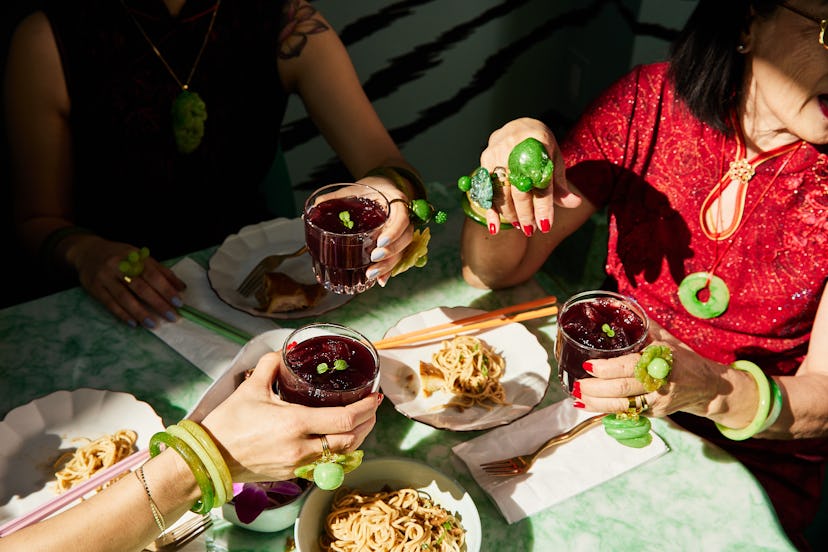For Humberto Leon, co-founder of Opening Ceremony, creative projects always turn into a family affair. Even before opening up Chifa, the Peruvian-Chinese restaurant that he and his family own in Los Angeles, the fashion world was familiar with his mom, Wendy. She not only served her signature soy sauce chicken at a fashion week party for Kenzo but also took a turn modeling for both of her son’s brands. So it’s no surprise that his latest endeavor draws inspiration from Popo Wendy, as she’s known to everyone (Popo is Cantonese for grandmother).
Launching today on Chifa’s site, Leon partnered up with candy artist Sweet Saba by Maayan Zilberman to create a capsule collection of edible jewelry inspired by Popo Wendy’s jade collection. “My mom grew up poor in China but her family would give her jade over the years at important events like funerals. She carried the pieces with her, first to Peru and then to the United States, where she only brings them out for special occasions now,” he explains. These heirlooms were then transformed by Zilberman into peach and lychee flavored versions of Popo Wendy’s array of bangles, pendants, and rings. The 88-piece drop (the number is deliberate as 8 sounds like fortune or wealth in Chinese) can be eaten or worn like real jewelry, as they’re mounted on gold vermeil.
In East and South East Asian cultures, jade is traditionally prized above gold or diamonds and considered a source of fortune and protection, frequently being carved into the religious shapes like that of the Buddha or other traditional ancestral gods and Bodhisattvas. Passed down through the generations, acquiring pieces signified wealth and the promise of a more prosperous future. “My mom imbued me with the importance of jade. She gave a necklace to me at birth and I've worn it every day. It's in all of my school pictures and it's gotten greener over time,” Leon explains. “She said it’s where I hold my luck.”
In a departure from its traditional and serious roots, Leon wanted to personalize jade to better represent his family’s unique sense of humor. “We’re very lighthearted, so we like tradition while still having fun,” he explains of the irreverent approach which includes both traditional pieces like bangles and circular Bi pendants (a traditional shape that dates back to Neolithic times and represents heaven in Chinese culture) to playful oversized rings shaped like giant bok choy or strawberries. Priced between $30 and $45, Leon’s version is also significantly more affordable than the real pieces, which can run anywhere from hundreds to thousands of dollars for high quality jade.
While the idea might be playful, Zilberman approached the process with respect. She worked closely with Leon and his family to examine all of Popo Wendy’s jewelry collection, some of which were centuries old. “I had a visceral reaction meeting her because she's so strong, beautiful and a force,” explains Zilberman. The two discovered commonalities, particularly in the way jade is traditionally buried with its owner for a period of time, before being exhumed and given to the surviving family. “I started Sweet Saba as an art project, inspired by a dream I had as a kid about burying my precious belongings in the ground only for them to turn into candy,” says Zilberman.
It’s evident Zilberman did her homework, as the collaboration bears an uncanny resemblance to genuine jade, down to the color gradations. No two are alike, a nod to how in real life a good jewelry salesperson would slip on various pieces to figure out which best suited your skin tone. Leon and Zilberman even include the red string necklace, which is another traditional element, with the Bi disc pendant. “My mom has specific braiding techniques on how to wear it so we made a little kit so that my mom could explain it to people,” says Leon. While you can eat it or wear it, every piece also comes with an acrylic box that can be used for display purposes.
To highlight the jewelry, Leon decided to shoot the pieces on three generations of his family: Popo Wendy, his sister Rica Leon, and his niece, Coltrane Liu. Clad in cheongsams, the three pose over a meal, showcasing the passing of rituals from one generation to the next. “We've gone through this era of trying to assimilate and be American but it’s time to embrace tradition and customs. I want to represent my heritage and bring that to the cultural landscape,” Leon says.
The jewelry was also photographed on friends like the director Spike Jonze, to highlight that the pieces are for everyone, as a way to invite them to celebrate Leon’s Chinese culture. Is he concerned that mainstream acceptance waters down the meaning of the jewelry? “As people who know about this tradition, it's never a fad. This is just part of our heritage and it'll be around forever,” he replied. Zilberman adds, “[Because it’s candy] it also becomes part of you as you eat it and there's something really intimate and poetic about that.” What’s more indicative of acceptance than literally embracing it into your body?
This article was originally published on
